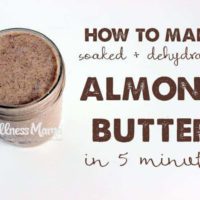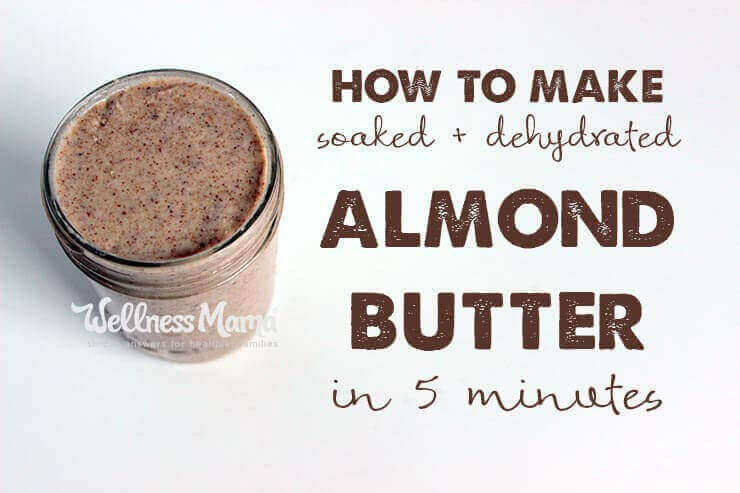Peanut butter is a staple in most American families, but did you know that the peanut is not a nut at all? It is actually a legume and in the same family as beans and soy. Our family avoids most legumes because of the impact they can have on the gut and instead use natural nut butters made from soaked nuts.
Like most foods, almond butter is quite simple to make yourself, and this homemade version is healthier for you and is easier on your wallet.
A Note About Almonds
Almonds, as well as other nuts, contain moderate levels of phytic acid and enzyme inhibitors that interfere with the body’s ability to absorb nutrients.
It is simple to reduce the phytic acid in nuts by soaking them before you eat them. The process involves soaking the nuts in warm salt water and then drying them in either a dehydrator or a very low-temp oven.
An easy way to do this is to dissolve 1 tablespoon of sea salt in 3-4 cups of warm water. Add 2 cups of organic, raw nuts (in this case, almonds) and soak for at least 7 hours (I like to leave them overnight). Drain the water and rinse in a colander. Then dry the nuts in a dehydrator or in a low-temp oven (ideally no more than 150 degrees) for 24-48 hours. Be sure that they are completely dry because any remaining moisture can allow the nuts to mold.
I go into much more detail in my post on the benefits of soaking nuts if you are looking for a bit more information.
Homemade Almond Butter Recipe
Almonds are packed with fiber, magnesium and vitamin E and are valuable for making many health food alternatives like almond milk, almond flour, and almond butter.
I use almond butter to make coconut no bake cookies which are a favorite at my house. Almond butter also makes a great topping on almond flour pancakes and can be added to smoothies to boost nutrients and give a rich, nutty flavor.
See below the recipe for different flavor variations of almond butter and a link to homemade almond milk!

Homemade Almond Butter Recipe
Servings
Ingredients
- 2 cups organic raw almonds soaked and dehydrated
- ½ tsp sea salt optional
- 1-2 TBSP liquid oil such as MCT olive, or walnut
Instructions
- Put the soaked and dehydrated almonds and sea salt in a high-speed blender or food processor.
- Blend at medium speed until the almonds are powdered.
- Continue to blend. At this point it will be necessary to add the liquid oil. You can start with 1 tablespoon but I ended up adding 2 tablespoons in order to reach the consistency I like.
- If your blade begins to spin freely, stop the blender or food processor and scrape down the sides, pushing the almond powder down to the bottom. It will be necessary to do this several times. If you have a Blendtec, the Twister Jar makes this part extremely easy and you will not need to add as much oil, if any at all.
- Continue to blend, stopping to scrape the sides when necessary, until you reach the creamy consistency of nut butter.
Nutrition
Notes
Almond Butter Variations
- Honey almond butter: For honey almond butter, replace 1 of the tablespoons of oil with honey (or both for a really sweet treat)
- Cinnamon pecan butter: Use pecans instead of almonds and replace 1 (or both) of the tablespoons of oil with real maple syrup. Follow the steps above until smooth. Add 1 teaspoon of cinnamon and pulse until incorporated.
- Other nut butters: Substitute any other nut you like such as hazelnuts, cashews, walnuts, or pistachios.
The Best Pre-made Almond Butter
Making your own almond butter is definitely the least expensive option and a way to ensure that you are getting a high quality almond butter by soaking and dehydrating the nuts yourself. If you don’t want to make your own, I highly recommend the Better Than Roasted brand of almond butter (and other nut butters) available here. These nut butters are certified organic and are soaked, sprouted, dehydrated, and made into butters without being heated to retain the most nutrients.
Make Almond Milk too!
Almond milk is another super easy thing to make at home and you’ll save a lot over store bought varieties. Here’s my favorite homemade almond milk recipe (and you can make your own coconut milk too if you prefer that!).
What is your favorite nut butter? Did you make it yourself?


Leave a Reply